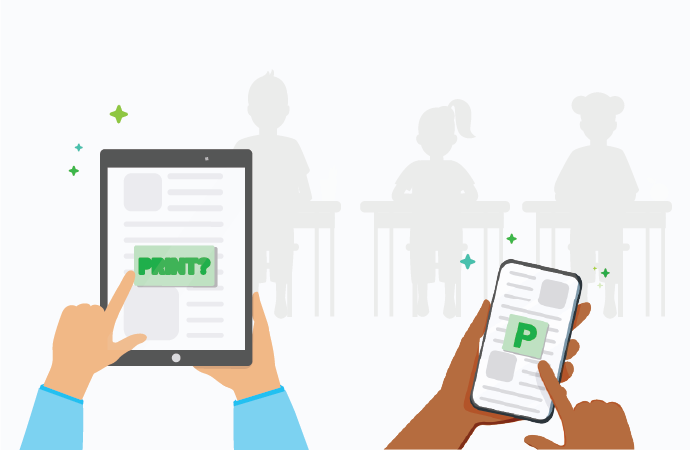With the shift towards technology use in schools, some are facing out-of-date devices, missing components, and a shortage of devices. While some schools are stocked with the latest shiny technology, many can’t afford to be constantly updating their equipment or to provide an individual computer for every student.
With BYOD, or Bring-Your-Own-Device, students work on their own laptops or tablets, which are generally more cutting-edge than school computers. BYOD as a concept has already taken over workplaces, and now BYOD in schools is a growing trend.
Students in K-12 are often banned from having mobile phones in the classroom, but that doesn’t mean they can’t use other devices such as laptops and tablets. So let’s explore the BYOD benefits in education.
BYOD benefit: More engaged students
Studies have shown that technology increases learner engagement and boosts students’ performance. But if you’ve ever borrowed someone else’s phone and asked how to turn it on (*raises hand), you’ll know that it can be tricky to figure out a device that’s different to the one you’re used to.
So when students are working on a laptop or tablet they’re already familiar with, it makes it that much easier to focus on the lesson… instead of scrambling around looking for the Menu button.
And as anyone who has met a teenager can tell you, they’re deeply engaged with their devices outside of the classroom. BYOD in schools taps into that leisure time after hours, turning their device into a learning tool that is chock full of educational apps.
That means they’re taking home all their lesson material and exercises, and can organise their classwork and homework from a single platform without switching devices. Plus, with apps and fun features at their fingertips, students are more likely to want to carry on learning at home.
BYOD benefit: Flexible teaching = better learning
Speaking of apps, BYOD gives teachers more creative ways to teach the curriculum material, and can even help them better assess students’ work and track their progress towards academic goals. Teachers also have greater flexibility to meet different learning needs.
For example, there are apps to help students with learning difficulties or translate words for students who speak English as a second language – while more advanced learners can use other apps and programs for individual practice.
With each student having internet connectivity on their device, they can access unlimited information on different subjects and even engage experts and local leaders from outside the classroom. This helps students apply learning to real life scenarios and hones their skills in collecting and interpreting information.
BYOD benefit: Easier digital collaboration
In schools, teamwork is key to effective learning. BYOD in education makes collaboration easier because it increases student engagement, which leads to better promotion and sharing of ideas.
Research can be done much faster and without countless trips to the library. Students don’t even have to be in the same place to work together – with plenty of online programs like Dropbox and Google Drive that enable document collaboration from separate devices.
BYOD also simplifies content sharing for teachers: using free apps, students can gain 24/7 access to classwork, assignments, test papers, and any audio or visual material – from wherever they are.
BYOD benefit: Fewer demands on IT Managers and SysAdmins
Not only does BYOD benefit students, but it can also make life easier for IT managers and sysadmins at the same time. For instance, forget playing whack-a-mole trying to spot inappropriate use of personal devices on campus. With permission granted to BYOD, users will no longer have a reason to find workarounds to using their own phone or laptop, reducing this as a security risk. Knowing they are allowed to use their own devices can also encourage awareness and adherence to a formal BYOD policy. It helps to make sure that this policy is clear about which devices and operating systems will be permitted and supported at your school, and how acceptable behavior is defined, to be most effective.
Additionally, BYOD in schools means IT teams no longer have to allocate time or resources to maintaining and updating cell phones and laptops. Not only does this offer cost savings but frees your IT team to use this support time on other tasks.
BYOD benefit: Schools save money!
Okay, we saved this one for last but let’s face it, this is a biggie. Schools are always looking for more effective ways to allocate their budget – but computer labs are expensive and the technology needs upgrading constantly as more advanced models are released.
BYOD let’s schools save money and resources they would otherwise have to spend on buying computers for every classroom. Students are asked to carry their own device, just as they do their own pens and paper, and they replace equipment themselves. But the important thing is that these cost savings allows schools to concentrate funding in other areas where they are most needed.
As a bonus, schools show that they’re ahead of the curve in terms of technology and foster a positive image in the community – with a reputation for innovation attracting new students.
BYOD benefit: The opportunity to learn digital discipline
Of course there are disadvantages of BYOD – most schools ban smartphone use because students find it distracting in the classroom. But when students use their own laptops and devices, it gives teachers the opportunity to teach “netiquette” (or should that be “techiquette”?)
Remember once students get out into the wide world, they’ll be using portable devices – so it’s important to prepare them for the workforce. This might mean putting guidelines in place to restrict use to learning, and deploying device management software to prohibit inappropriate use.
Does your school need BYOD for printing? Try PaperCut’s free BYOD solution, Mobility Print .


